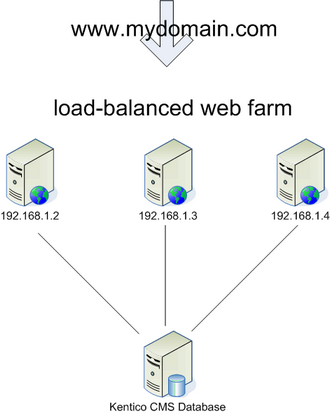Overview |

|

|

|

|
|
Overview |

|

|

|

|
|
|
||
Native web farm support in Kentico CMS provides the following features:
•It synchronizes the changes made to the site settings or content on one of the servers to all the other servers.
•It synchronizes the files uploaded to the site to all other servers. This is used only if you store the uploaded files on the disk or on both disk and in the database.
The following image shows the structure of the web farm and how the synchronization works:

If you change some settings or upload a file using server 192.168.1.2, the other servers do not know about it in a standard scenario. However, if you're using the Web farm synchronization module, it automatically creates a new synchronization task in the database and notifies the other servers so that they process their synchronization task. To learn more about how the synchronization works, refer to the Synchronization mechanisms topic.
To learn how to add web farm servers into the system and configure them, please see the Defining web farm servers topic.
Developers can write custom tasks to be used by this module. The Creating custom web farm synchronization tasks topic contains more information.
The Web farm synchronization internals and API sub-chapter provides information about the database tables and classes used by the module and examples of how web farm synchronization can be managed using the API.
|
Using Kentico CMS on a web farm without the Web farm synchronization module
You can use Kentico CMS on a web farm even if you do not use the web farm synchronization module, especially if you do not store uploaded files in the file system. Then, the only limitation is that if you change the settings or page content on one of the servers, the other servers may keep using the old version of the settings in their memory/cache until the web application is restarted or cache content expires.
Please note: The web farm support doesn't replace any load-balancing or web farm management tools. |
|
SSL in a web farm environment
If you use an SSL offload device or accelerator as part of your web farm, you may encounter problems with a redirection loop if your website is configured to require SSL for the administration interface or on specific pages.
For this type of scenario, it is necessary to add some custom code to your website, as described in the SSL (HTTPS) support topic in the Membership, permissions and security -> Security chapter of this guide. |